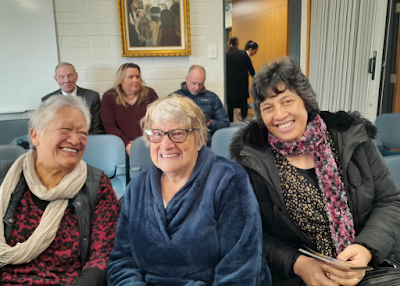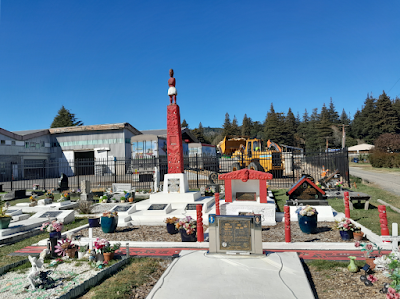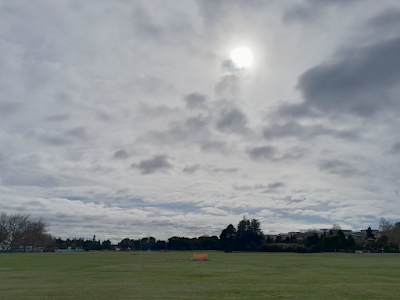This week we finished setting up our house and made a visit to the living Māori Te Papaioru Marae (village center) of Ōhinemutu, which was settled by the Ngāti Whakaue iwi (tribe), a sub-tribe of the Te Arawa.
Māori totem at Ōhinemutu. The meaning of the place name is as follows: Ō: place of; hine: girl; mutu: cut off. The chief Ihenga,
who discovered Lake Rotorua, had a daughter called Hinetekakara. She was captured
and murdered, and her entrails were cast into the lake. Ihenga searched
frantically for her, and when he found her intestines caught on a snag at the
edge of the lake, he set up a memorial stone that he named Ōhinemutu (The place
of the only girl, or The girl cut off.)
I forgot to include this photo of Elder Rooks & Sister Rooks when we first arrived at the mission home in Hamilton. We were greeted by Jeffrey Nikoia, the Mission Leader, a wonderful and inspired disciple of Christ.
Two of the three cats who roam our yard: this ginger & white, rather mangy half wild cat warming himself over the geothermal stream, and
...this beautiful fluffy black cat with golden eyes who has obviously been owned by a family before. He seems well fed but likes hanging around our house. I am tempted to feed him but really shouldn't.
After more than a week setting up our house--the new dryer came! And the modem! We have communications now! and washing all the windows, the car, and the garbage cans (after a trip to The Warehouse for towels and cleaning supplies and a hose,) --we made forays into the neighborhood and found this little shopping area on Lake Road, including the Monster Fruit store, owned by a family from India.
Lots of fresh fruit, herbs and spices, Indian, Thai, Mexican and other international seasonings and plastic-wrapped meats of unknown origins, Bundaberg ginger beer and creaming soda (yum!) and Hai Chews, among other things. I brought home a bag of mismatched Granny Smith apples and made apple turnovers for the Elders and Sisters of the Rotorua District. They appreciated every last one. Elder Rooks was sorry they were all eaten.

On the way home from the Monster Fruit Market is Wendy's Fish Shop, typical of all local fish and chips shops with its offerings of Indian, Chinese, and English dishes, with the poster of New Zealand Commercial Fish Species on the wall. We ordered the $39 special, which includes a ton of thick cut potato fries, Potato Fritters--the length of a thin-sliced potato, battered and deep fried--several mild fat sausages, and probably 9 generous pieces of batter-fried fish, which was excellent, if greasy. A person could founder on this kind of food. It fed us for several days. We haven't felt the need to visit Better Quality Pies next door. Fish & Chips reheat a lot better than meat pies.

The next time we visited Wendy's Fish Shop we ordered the $15 special, which was still enough for two meals. Here Elder Rooks waits to unwrap the fish and chips, which comes with a free bottle of your choice of soda. We chose L&P, Lemon & Paeroa (a mineral spring water), "World Famous in New Zealand." It was nice and lemony and sparkly.
Today's catch
On Friday we made the 1-1/2 mile trek to Ōhinemutu, on the shores of Lake Rotorua. We passed the entrance to Kuirau Park, a fairly large park which includes the bubbling springs, a rugby field, a geothermal aquatic center, and some belching gas that earns Rotorua the affectionate name of Sulphur City. The entrance here is deceptively pleasant looking. If you follow the pathways you will run into stifling, billowing clouds that you can't see past and will send you home coughing with eyes stinging.
,
It looks quite pretty against the blue sky but I would hate to live across the street from the worst of the sulfur smells so far.
On the way up the hill to Ōhinemutu, we passed the large and beautiful Rotorua Hospital and the Te Whatu Ora Lakes Mental Health and Addiction Services, with a commanding view of the lake and town of Rotorua.
One of the notable features of the Te Papaioru Marae is the Tama-te-kapua wharenui (meeting house or focal point of a marae), dedicated in 1878 to ratify the peace between the Te Arawa and Waikato tribes. The legend of Tama-te-kapua, the ancestor of the Te Arawa people surrounding Lake Rotorua, is as follows:
“The story of Te Arawa begins in Hawaiki, the distant land
of our ancestors. Our iwi (tribe) is
named after the Te Arawa waka (canoe) that brought them to the shores of Aotearoa (New
Zealand). Theirs was an epic journey; one that took courage, skill, and
powerful magic to survive.”
Houmaitawhi was a chief of a tribe in Hawaiki (Raiatea, Society Islands, French Polynesia). The trouble
began when the neighboring chief Uenuku ate the pet dog of Houmaitawhi, whose two
sons Tama-te-kapua and Whakaturia discovered it missing and went looking for it. When they entered
Uenuku’s village they were delighted to hear an answering howl – only to
discover that the sound was coming from inside the belly of Uenuku.
The two brothers schemed how to take revenge for this
insult. They stole the kuru (breadfruit), night after night, from Uenuku’s
precious tree, on stilts. After they were found out, in the ensuing battle, Tama-te-kapua’s forces won, but Houmaitawhi
told his son to seek out a peaceful life in a new land.
A great tree was felled and the waka (canoe) was built,
ready to take on the fearsome ocean waves. At least 30 people readied
themselves and packed their kete ready to join Tama-te-kapua on the long and
dangerous voyage. Sailing south, the people made their way to the Bay of Plenty
in Aotearoa, New Zealand. Those who made their way to the shores of Lake Rotorua valued the geothermal waters for bathing, cooking, and heating.
On the other side of the marae is the Tudor-style St. Faith's Anglican Church, built in 1910. We were not able to see inside the whanui or the church, which are both said to be beautifully carved. Perhaps some other time.
St. Faith's is surrounded by vaults and grave memorials, one the reasons we came to Ōhinemutu--to take photos for the BillionGraves website.
The Muruika Urupa (Soldier's Cemetery) on Muruika Point on Lake Rotorua. Most are the soldiers of the 28th Māori Battalion who returned from the Second World War, but some are World War 1 veterans as well.
We took over 100 photos of the memorial markers here and around the church, using the Billion Graves app, which pinpoints each marker with GPS data. The Find A Grave site marks this as 100% complete but has only photographed ten markers, although these are accompanied by additional personal information. Elder Rooks has been spending his spare time transcribing headstones so the information will be available to Family Search and other genealogical sites. At least one of the soldier's names was Hagoth.
Pink flowers on the shores of the lake
Black swan near the shore
Across the fenced-in geothermal area we could hear the sound of children's voices at the school whanui of the Māori village.
The bust of Queen Victoria, presented by the Queen in 1870 as a mark of her gratitude to the tribes which maintained their allegiance to her during the wars of the 1860s
You could hear boiling water under these rocks. Occasionally there are spurts of hot water, geyser-fashion. A series of round vents are stuck in the grass nearby. Elder Rooks kept putting his hands near steaming pipes and corroded sidewalks to see how hot they were. Too hot to touch, he said.
On Saturday morning we set off for the Saturday Market that takes place each week on the south side of Kuirau Park. It is a fifteen-minute walk for us. We passed where the steaming geothermal stream comes under Tarewa Road onto our side of the street.
We went through the aquatic center buildings and across the rugby field to Pukuatua Street
...to the tents of hardy vendors, offering everything from prayers to manuka honey to grilled meat skewers in the food court, which smelled wonderful.
The Saturday Market raises money for the Rotorua Rotary club.
On the way back, we found this little Urupa not far from our house. It is not on any known map. It is mostly a well-cared for lawn with a central memorial vault and one memorial on the side fence.
Because there were no headstones, the record of all the other people buried here are lost.
This gentleman came from the house across the street to tell us about the cemetery, which his family has been maintaining. Here Elder Rooks is carrying the bag of oranges we bought at the Saturday Market, along with two mugs and some Kawakawa salves, soap, and herbal tea. Kawakawa means bitter in Māori, and is considered a very useful medicinal herb.
Here Manahi stands alongside the headstone of his grandfather Manahi, whose gravesite is the only one marked in the cemetery. He told us that his grandfather knew the names of everyone in the cemetery, and he berates himself not writing them down. He said that many of the people buried here died in the 1918 flu epidemic. We would love to talk to Manahi again. He is a fount of knowledge of families and histories in this part of New Zealand.
Mr. and Mrs. Pukeko, foraging under the citrus trees. We have picked lemons, a sweet tangerine, and a sour orange.















































































